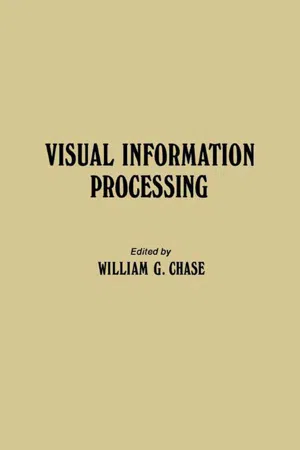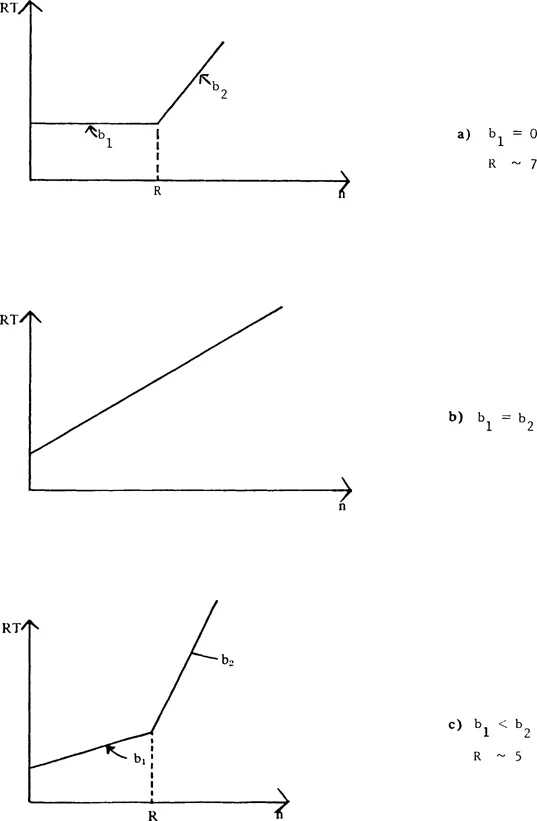
eBook - ePub
Visual Information Processing
Proceedings of the Eighth Annual Carnegie Symposium on Cognition, Held at the Carnegie-Mellon University, Pittsburgh, Pennsylvania, May 19, 1972
- 572 pages
- English
- ePUB (mobile friendly)
- Available on iOS & Android
eBook - ePub
Visual Information Processing
Proceedings of the Eighth Annual Carnegie Symposium on Cognition, Held at the Carnegie-Mellon University, Pittsburgh, Pennsylvania, May 19, 1972
About this book
Visual Information Processing documents the Proceedings of the Eighth Annual Carnegie Symposium on Cognition, held at the Carnegie-Mellon University, Pittsburgh, Pennsylvania on May 19, 1972. This book compiles papers on the results from ongoing, programmatic research projects that aim to develop information processing models of cognition. The role of visual processes in cognition and language comprehension and explicit computer simulation of the memory-scanning task are discussed in detail. Other topics include the chronometrie studies of the rotation of mental images; function of visual imagery in elementary mathematics; and semantic prerequisites for comprehension. The production system for counting, subitizing, and adding; visual processes in linguistic comprehension; and models of control structures are also deliberated. This publication is a good source for students and researchers interested in images.
Frequently asked questions
Yes, you can cancel anytime from the Subscription tab in your account settings on the Perlego website. Your subscription will stay active until the end of your current billing period. Learn how to cancel your subscription.
At the moment all of our mobile-responsive ePub books are available to download via the app. Most of our PDFs are also available to download and we're working on making the final remaining ones downloadable now. Learn more here.
Perlego offers two plans: Essential and Complete
- Essential is ideal for learners and professionals who enjoy exploring a wide range of subjects. Access the Essential Library with 800,000+ trusted titles and best-sellers across business, personal growth, and the humanities. Includes unlimited reading time and Standard Read Aloud voice.
- Complete: Perfect for advanced learners and researchers needing full, unrestricted access. Unlock 1.4M+ books across hundreds of subjects, including academic and specialized titles. The Complete Plan also includes advanced features like Premium Read Aloud and Research Assistant.
We are an online textbook subscription service, where you can get access to an entire online library for less than the price of a single book per month. With over 1 million books across 1000+ topics, we’ve got you covered! Learn more here.
Look out for the read-aloud symbol on your next book to see if you can listen to it. The read-aloud tool reads text aloud for you, highlighting the text as it is being read. You can pause it, speed it up and slow it down. Learn more here.
Yes! You can use the Perlego app on both iOS or Android devices to read anytime, anywhere — even offline. Perfect for commutes or when you’re on the go.
Please note we cannot support devices running on iOS 13 and Android 7 or earlier. Learn more about using the app.
Please note we cannot support devices running on iOS 13 and Android 7 or earlier. Learn more about using the app.
Yes, you can access Visual Information Processing by William G. Chase in PDF and/or ePUB format, as well as other popular books in Psychology & Physiological Psychology. We have over one million books available in our catalogue for you to explore.
Information
PART I
VISUAL PROCESSES IN COGNITION
QUANTIFICATION PROCESSES
David Klahr, Carnegie-Mellon University
Publisher Summary
This chapter discusses information processing model, cast in the form of a production system that could be used to explain different patterns of success and failure and the effects of training. At the heart of the production system were some things called quantification operators. These quantification operators were nice examples of what Walter Reitman meant when he once characterized the information processing approach as a way to invent what is needed to be known. They were essential to the logic of the model discussed in the chapter, and so their existence was postulated. The overall research strategy is to formulate models of performance of the developing organism at two different points in time, and then to formulate a model for the transition or developmental mechanisms. Adopting an extreme engineering approach to the information processing system, changes can be viewed in terms of four major classes of variables: (1) programs, (2) data structures, (3) capacities, and (4) rates. Changes in the first two result from software variation; changes in the last two result from hardware variation.
The goal of the research to be described in this paper is the formulation of an information processing model of cognitive development. For several years now, Iain Wallace and I have been engaged in this pursuit, and last year, in the 7th Carnegie Cognition Symposium, we reported upon some aspects of our work (Klahr and Wallace, 1972). The focus then was upon the analysis of the classic Class Inclusion (CI) problem, first used by Piaget to assess one of the components of the stage of concrete operations (Piaget, 1952). In the CI task the child is shown a collection of, say, 10 red objects, 7 of which are square and 3 of which are round, and he is asked, “Are there more red things or more round things?” In general, children below age four fail this task, and children above age 7 pass it. We formulated an information processing model, cast in the form of a production system, that could be used to explain different patterns of success and failure and the effects of training. At the heart of the production system were some things we called quantification operators. These quantification operators were nice examples of what Walter Reitman meant when he once characterized the information processing approach as a way to “invent what you need to know” (Reitman, 1967). They were essential to the logic of our model, and so we postulated their existence. We have since been engaged in extending our knowledge about quantification operators in two related directions. One is a theory about the relationship of such operators and their development to a wider range of Genevan tasks, in particular, conservation of quantity and transitivity (Klahr and Wallace, 1973). The other is an empirical study of quantification in adults, and that is the topic of this paper.
Our overall research strategy is to formulate models of performance of the developing organism at two different points in time, and then to formulate a model for the transition or developmental mechanisms. The research to be reported and reviewed here focuses almost entirely upon adult performance, and thus, represents only one aspect of this three-pronged approach.
Quantification Operators
A quantification operator is an organized collection of elementary processes that takes as input the stimulus to be quantified (e.g., a collection of blocks) as well as specified constraints (e.g., red only) and produces as output a quantitative symbol. Quantitative symbols are labeled internal representations (e.g., two, long, tiny) that can be used in quantitative comparisons. Given two such symbols, the system can determine their relative magnitudes; whereas given two non-quantitative symbols, it can only determine sameness or difference.
There is a compelling logical necessity for the existence of quantification operators in a wide variety of tasks, including those central to the paradigms of developmental psychology. In class inclusion, in transitivity, and in conservation tasks, the child is asked to compare the amount of two or more collections. In order to make the comparison, he must have some quantitative symbols to compare; and in order to generate such symbols from the stimulus, he must have some quantification operators.
For normal adults, all of the above-mentioned tasks are easy. Thus, we would expect to find the underlying quantification operators in their most stable and fully developed form in adults, and it is to an analysis of quantification operators in adults that this paper is primarily addressed. However, we shall return to the developmental problem after presenting the main results of investigations using adult subjects, both from our own laboratory and from the work of others.
There seem to be three quantification operators that are used by adults: subitizing, counting, and estimation. These are venerable topics in psychology. Some of the phenomena with which they deal have been studied in terms of “immediate apprehension” for over a century (Jevons, 1871) and the invention of the term “subitizing,” as well as a comparison of the three processes, resulted from investigations in the late forties by Kaufman, Lord, Reese, and Volkmann (1949). Thus, there is a strong flavor of new wine in old bottles, with the new contents for the old labels having three characteristics. First, they are based upon a process analysis of the fine structure of the observable phenomena; second, these subprocesses are related to recent advances in our knowledge about the parameters of some of the central mechanisms, such as short-term memory; and finally, the analysis is ultimately devoted to the end of accounting for the development of the processes and the relationship between that development and more complex conceptual activity.
Sybitizing
The early studies of what came to be called subitizing were centered upon the existence and extent of “immediate apprehension.” The empirical question was whether the time required to quantify a collection of n items presented to view was independent of n, and if so, for what values of n. Figure 1(a) shows the hypothetical results from such a model. Initially, the answer seemed to support such a model, with an upper value of n approximately equal to 6 or 7 (e.g., Jevons, 1871). Von Szeliski (1924) discovered a continuous curve, arguing for Model b. During the late forties a brief series of papers presented evidence supporting or refuting Models a or b (Jenson, Reese, & Reese, 1950; Kaufman, et al, 1949; Saltzman and Garner, 1948). The final outcome of that exchange, reviewed by Woodworth and Schlosberg (1954) and further supported by the experiments reported below, is that Model 1c seems to be correct.

Fig. 1 Predicted reaction time as a function of n for three models of “immediate apprehension.”
When we first began to attempt to determine the effect of different quantification processes upon children’s performance on logical tasks, we found that for all its familiarity as a phenomenon, subitizing was essentially unexplained (and a bit unloved). For example,Beckwith and Restle (1966) find it
“… amazing that although everyone knows that objects are enumerated by counting, most studies of enumeration or the judgment of number have attempted to rule out coun...
Table of contents
- Cover image
- Title page
- Table of Contents
- CONTRIBUTORS
- Copyright
- Dedication
- CONTRIBUTORS
- PREFACE
- PART I: VISUAL PROCESSES IN COGNITION
- PART II: VISUAL PROCESSES IN LINGUISTIC COMPREHENSION
- PART III: INFORMATION PROCESSING MODELS
- AUTHOR INDEX
- SUBJECT INDEX